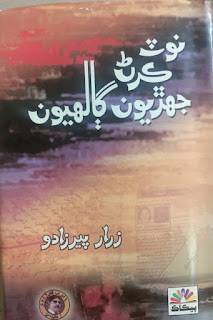Dr. Mazhar Ali Dootio
In the dynamic landscape of personal and professional development, the principles of learning, growth, and success stand as pillars of strength and resilience. These concepts are not mere buzzwords; they represent transformative journeys that have the power to redefine our lives. In this article, interconnectedness of learning, growth, and success will be explored, and how they pave the path towards fulfillment and achievement.
Learning: A Lifelong Journey
Learning is not confined to the walls of
classrooms or the pages of textbooks; it is a continuous process that unfolds
throughout our lives. It begins with a spark of curiosity, a simple question
that ignites our quest for knowledge: "Why?" Embracing this curiosity
opens doors to new worlds of understanding and discovery. Whether we are recent
graduates embarking on our professional journeys or seasoned professionals
seeking to expand our horizons, the pursuit of learning is an ever-present companion.
It transcends boundaries and disciplines, propelling us towards personal and
intellectual growth.
Education serves as the foundation for learning,
providing individuals with the tools and skills necessary to navigate the
complexities of the world around them. While traditional education institutions
such as schools, colleges, and universities play a crucial role in this
process, education extends far beyond the confines of formal classrooms.
In the article, education is portrayed as a
holistic journey that encompasses not only the acquisition of knowledge but
also the development of critical thinking, communication, and problem-solving
abilities. It emphasizes the importance of education in shaping how individuals
interact with their environment, society, and relationships.
Moreover, education is depicted as a lifelong
endeavor that continues beyond formal education settings. It fosters a sense of
curiosity and exploration, encouraging individuals to ask questions, seek
answers, and pursue new possibilities. This emphasis on curiosity underscores
the transformative power of education in fueling innovation and creativity,
driving forward progress and achievement.
Therefore, the significance of education for
learning lies in its ability to empower individuals with the skills, knowledge,
and mindset necessary to thrive in an ever-changing world. It serves as a
catalyst for personal growth, societal progress, and the realization of
individual potential.
Growth: Nurturing the Potential Within
Personal growth is the cornerstone of every
remarkable achievement. It is a transformative journey of self-discovery, where
we delve deep into our innermost selves to uncover our strengths, weaknesses,
and aspirations. Through continuous learning and introspection, we evolve,
refining ourselves and striving towards realizing our fullest potential.
Whether in our personal or professional lives, growth naturally emerges as a
result of our dedication to learning and development.
True growth empowers us to adapt to change,
overcome obstacles, and embrace new opportunities with confidence and
resilience. It is not merely about acquiring knowledge or skills, but about
cultivating a mindset of continuous improvement and self-mastery. Growth
enables us to navigate life's challenges with grace, harnessing our inner
strength to thrive in the face of adversity.
In essence, growth is the process of expanding our
horizons, pushing beyond our comfort zones, and unlocking new levels of
capability and understanding. It is about embracing change, embracing
challenges, and embracing the journey of self-discovery with courage and
determination. Through growth, we evolve into the best versions of ourselves,
ready to conquer new heights and make meaningful contributions to the world
around us.
Success: Defining Our Own Path
Success is a deeply personal journey, shaped by
our unique values, aspirations, and life experiences. While for some, success
may manifest as achieving financial stability or gaining professional
recognition, for others, it may revolve around nurturing meaningful
relationships or making a positive impact on society. Regardless of its form,
success is intricately intertwined with our ongoing process of learning and
growth. It's not just about reaching a particular destination; rather, it's a
continuous evolution of striving and self-discovery.
At its essence, success goes beyond superficial
markers of material wealth or a relaxed lifestyle. While these may contribute
to a sense of achievement, true fulfillment and purpose often stem from
pursuing deeper, more meaningful endeavors. Success is about more than just
tangible accomplishments; it encompasses intangible qualities such as
happiness, fulfillment, and inner peace. It's about living authentically, in
alignment with our values and aspirations.
In this journey of success, personal growth and
meaningful connections hold significant importance. It's about continuously
striving to become the best version of us, embracing learning opportunities,
and evolving with each experience. Success is also about fostering genuine
relationships, finding joy in our interactions, and leaving a positive impact
on the world around us. It's about finding fulfillment in our pursuits,
experiencing genuine happiness in our relationships, and leaving a meaningful
legacy for future generations to cherish.
Ultimately, the purpose of success is to lead a
purposeful and fulfilling life, guided by our deepest values and aspirations.
It's about finding harmony and balance across all aspects of our lives – be it
in our careers, relationships, health, or personal well-being. Success isn't
merely a destination to be reached; it's a lifelong journey to be embraced with
resilience, marked by growth, and fueled by the pursuit of happiness and
fulfillment.
In conclusion, the pursuit of learning, growth, and success is a lifelong endeavor that holds the power to transform our lives. By embracing curiosity, nurturing our potential, and defining our own paths to success, we can unlock the full spectrum of our capabilities and chart a course towards fulfillment and achievement. As we navigate the complexities of the modern world, let us remember that our journey is not defined by where we start but by the steps we take and the lessons we learn along the way.











